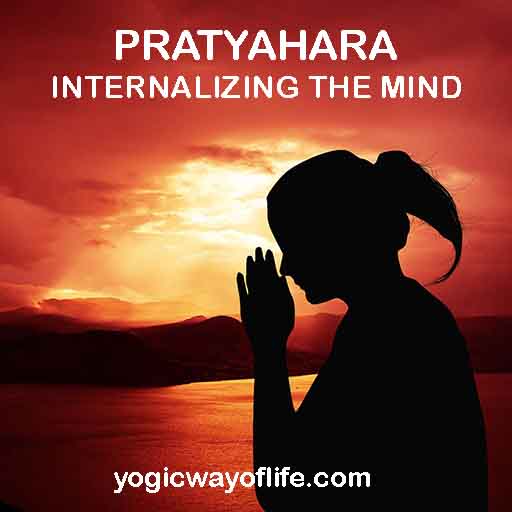Pratyahara or the method of internalizing the mind is the 5th step in the 8-step Ashtanga Yoga of Maharishi Patanjali. Yoga Sutras talk of Asana or postures for steadying the body and Pranayama for stabilizing and controlling the breath, mind and senses. These practices lead to a state of withdrawal of senses also known as Pratyahara which prepares the mind for practice of meditation.
In the 8-fold path of yoga, the first 4 namely Yama, Niyama, Asana and Pranayama are considered the external limbs of yoga, while the last 3 namely Dharana, Dhyana and Samadhi are considered the internal limbs of yoga. Pratyahara is classified by some under the external limbs of yoga; while some consider it as a bridge between the external and internal practices of yoga.

Pratyahara comes from two sanskrit root words – Prati which means against or away and Ahara which means food or inputs. Pratyahara is the practice of withdrawing the senses from the sense objects. When the mind is withdrawn from the external senses, it rests in its own natural state.
In another classical yogic text, Gheranda Samhita, Sage Gheranda explains that the knowledge of Pratyahara destroys the six enemies of man. Here, the sage is referring to the six defects of the mind namely lust, anger, greed, delusion, pride and jealousy which are also known as the shadarivargas. Pratyahara which is commonly translated a “Withdrawal of the senses” from the sense objects has more to it. Pratyahara also implies an inherent detachment to all external objects as well as internal emotions that take us away from the stillness of the mind. By practice of detachment, Pratyahara is achieved.
In the Bhagvat Gita, the analogy of the chariot with five horses is given. Human intelligence (Buddhi) is compared to the charioteer who is riding a chariot (the human body) with five horses (the five senses). The mind is the reins. By controlling the horses (the senses) with the reins (the mind), the charioteer can maintain a steady course. The Bhagvat Gita also gives the example of the turtle which can retract its limbs inside the shell at will. The same way, the yogi withdraws the mind from the senses and becomes centered in the self.
Methods for Pratyahara or Centering of the Mind
- Pranayama – is considered the precursor to Pratyahara. By practicing breath control, the mind is automatically withdrawn from external senses and gets concentrated on the breathing process, leading to stillness of the mind. The practice of Kumbhaka or holding of breath is especially useful for achieving a steady mind.
- There are many types of Pranayama. One of them, called the Bhramari pranayama or is particularly useful to internalize the consciousness. In this practice, the ears are plugged using the fingers and the eyes are closed. Mind is focussed on the sound of M-kara or N-kara in the heart or the eyebrow center bringing about introversion.
- Yoni Mudra – is a practice of shutting off all sense inputs to the brain, by physically blocking all the sense organs including the eyes, ears and the nostrils. This practice forces the mind to focus on internal activities in the Chidakasa or the inner psychic space, thereby stilling the mind and preparing it for higher practices of meditation.
- Trataka or the practice of concentration on a point or traditionally on the candle flame helps to shut off the senses and focus one’s attention on a single point. This produces the withdrawal of the senses from every other object or sense input.
- Yoga Nidra is a practice done in Shavasana with eyes closed and slow steady breathing. The mind is made to visualize the various parts of body from toes to head. This is followed by other visualisation techniques. During this process, the mind is not allowed to wander into any input from the senses, thereby leading to stillness of mind.
The above mentioned techniques are not exhaustive by any means. In fact, any method that focusses and internalizes the mind will naturally bring about Pratyahara. Maintaining a witness state in all activities or even absorption during devotional singing can lead to the state of Pratyahara.
Pratyahara is the bridge between the external practices and internal absorption and is the gateway to higher states of consciousness.

Respecdted Madam/Sir
Thank you for sending this information.
Regards
Arun Kumar.R